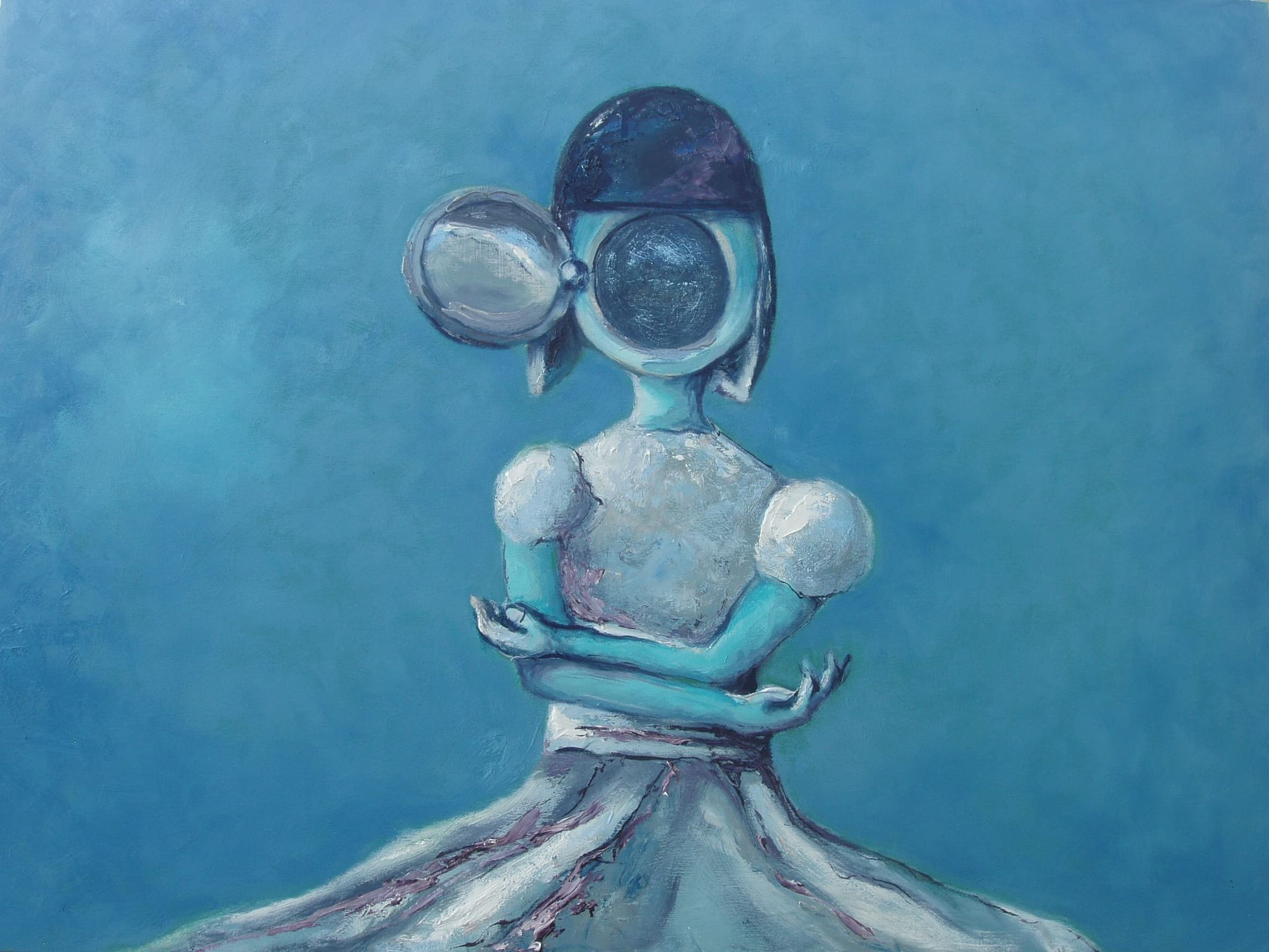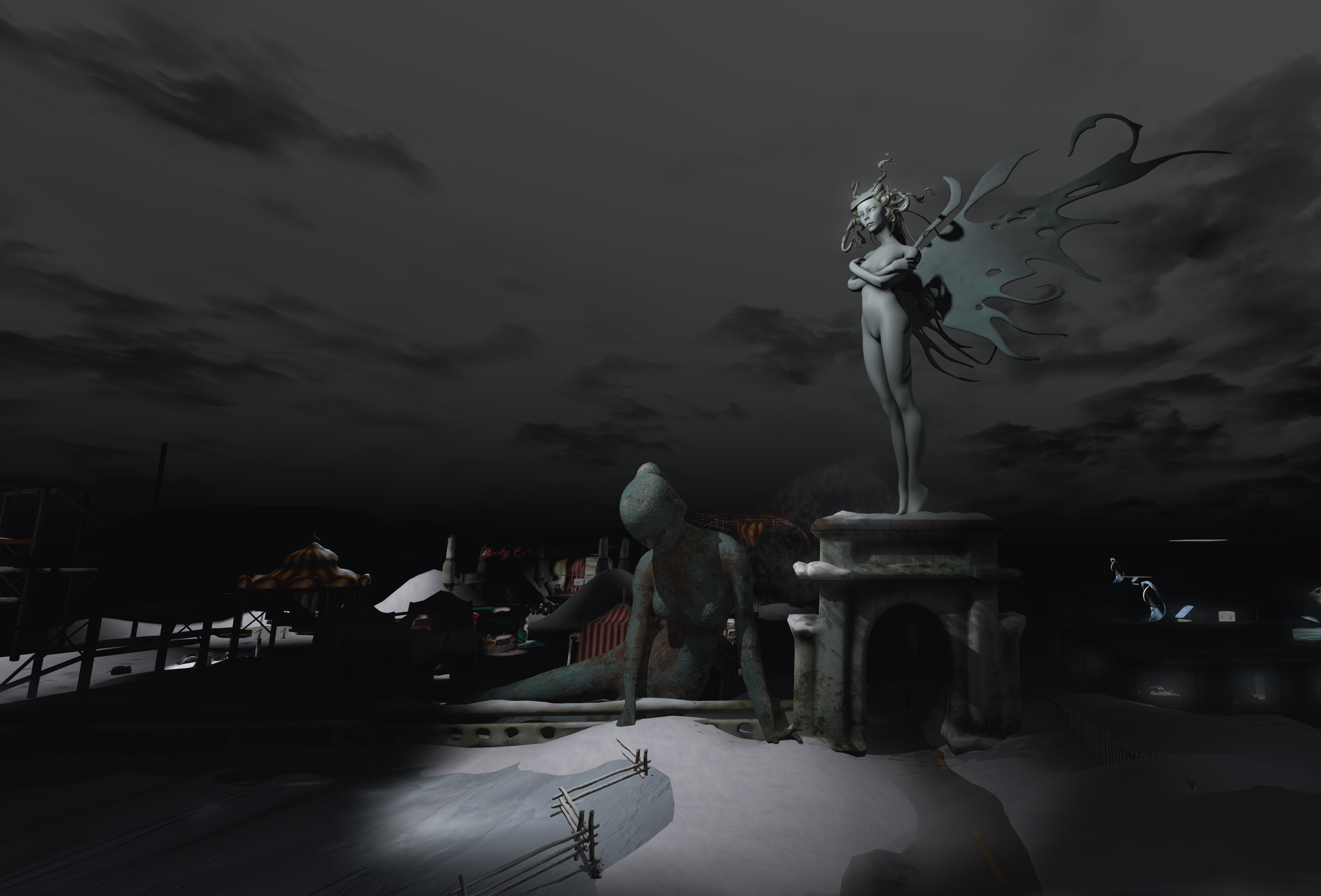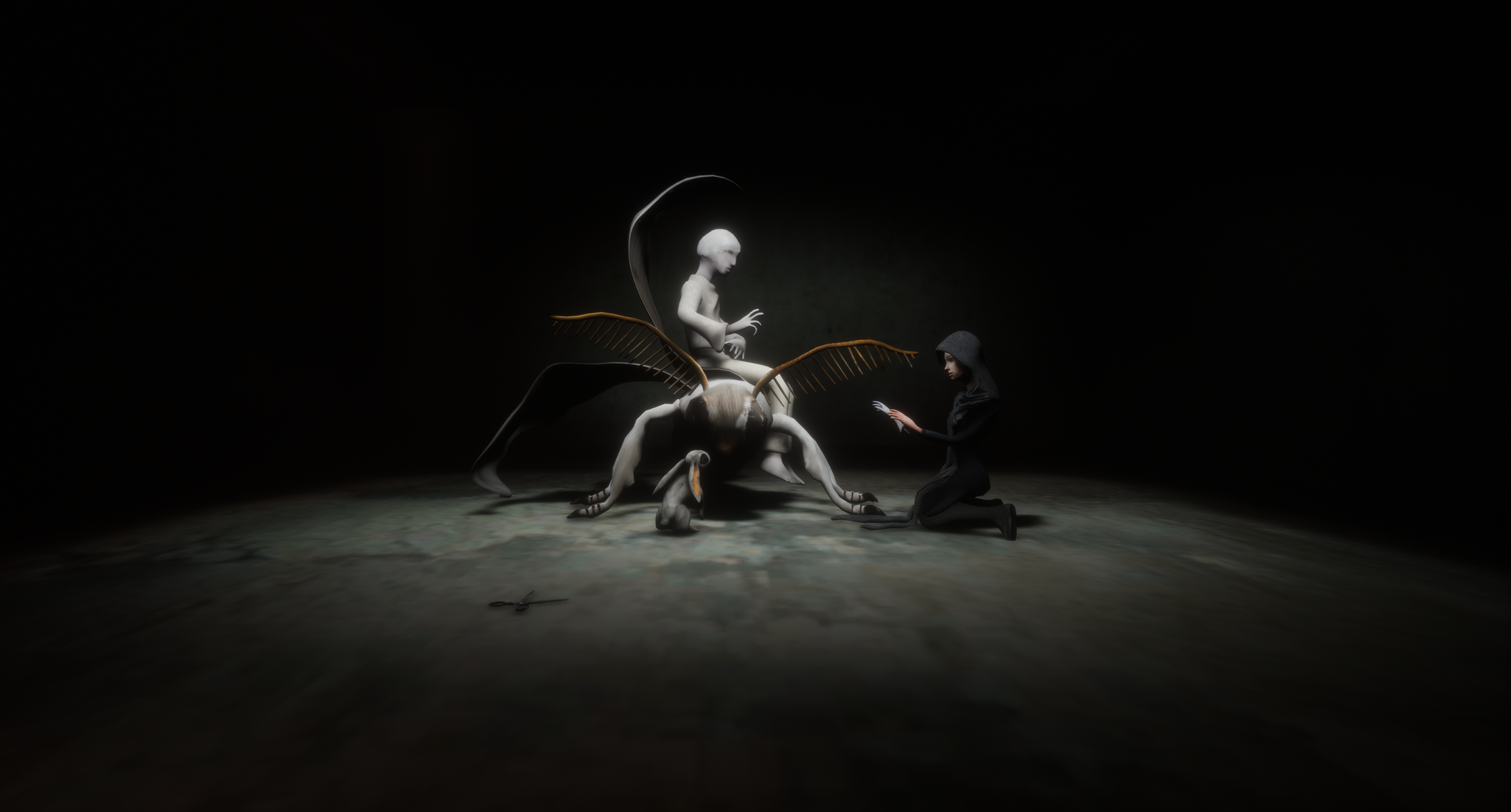Worship at the Altar of Immersivists
Written by Abel Streeter
Photography by Eli Streeter & Images provided by Bryn Oh
Claxxon 5- Immersivist Artist…grabs your attention on a rusted, metal sign that dominates the horizon, as you enter into Bryn Oh’s newest virtual artwork. Many questions race through your curious mind, as you venture forth into this immersive experience. This is Lobby Cam.
From the moment your pixel feet hit the ground, the experience begins. Attach the hud, follow the graphic settings and click the wall, which will immediately break away to reveal golden fields of corn, stretching as far as the naked eye can see. Rolled hay bales punctuate the view; fluffy dandelion clocks drift on the breeze; a worn out, rickety fence guides you gently on. Scanning the distance, a rotating windmill draws your attention, beside a squat, wooden farm house. You are now in Saskatchewan. Follow the train tracks to locate the red, Canadian mail box where you can be at one with the creator and post a letter to Bryn herself, to influence the story outcome, if you collect items to write it with; a stamp, paper, pen and envelope.
This installation is of great importance to both Bryn and the Second Life community as it received a National Arts grant from the Canada Council for the Arts, thus validating the virtual work of such artists and bringing positive attention to our community. Bryn is a renowned Artist within Second Life with work spanning over a decade. Each piece of work linked together to the next to weave a rich, immersive tapestry of Bryn’s story. With abundant intertextuality and references to past work, Lobby Cam, presents an interactive experience which broaches topics such as social isolation, obsession and online connections. Detailing the story of a lonely farmer, living in a virus gripped world, who becomes obsessed by a woman he watches on the stream of a lobby camera thousands of miles away. He reaches out and begins to talk to her and form deep emotions. Become a voyeur in their story by visiting the lobby with cafe and piecing together the lost pages, CLICK your way around the buildings to discover hidden gems such as, video links, teleports to other rooms and a whole range of 70s retro merchandise.
I greatly admire Bryn Oh, so it was a privilege to be able to interview her and delve inside her creative mind to discuss her new exhibition and discover a little more about her processes, her inspirations and her evolution.
Please explain the message behind your new exhibition?
In my work I like to create narrative questions which visitors will debate with each other; however, I wish these topics to walk a grey area where the moral dilemma is not clearly one sided. In previous artworks questions might be things like would you digitally preserve your memories so you can live forever in other bodies? Or do you feel life is special because it is finite? If you could preserve your memories digitally, would it be ok to edit out the bad things or do we need sorrow for joy to exist? In the new work; I touch on technological voyeurism and projecting onto other people things you think you learn from a screen. The main character may seem creepy to some, while others might understand his longing and confusion. In our world we are given, and must navigate, technology before we really understand it and often we do this using etiquette from earlier times. For example, at Easter I noticed at one point that I was the only person not looking at their phone in a room full of people. People were still talking to each other but the phones were a part of the gathering. They even facilitated it. If you read a book in a room full of people it would be odd and some would find it rude, yet if you put 90% of your attention towards a phone it is now different and acceptable to some yet not to others. Similarly we might look at Elon Musk and his purchase of Twitter. Do we know what that means? Some imagine his desire to have unlimited free speech will result in a toxic environment of racism, hate etc. Where other countries will have an easier time destabilizing their enemies by intentionally stirring up hatred with conspiracy theories and so on because moderators of content can be construed as agents who stifle free speech. Or we may look back a year from now and say ok we wrung our hands over nothing. The truth is we just don’t know but fear the technology could, at worst, cause a civil war or at best do nothing at all. That is quite a wide range of possible results and it’s because it is so hard to predict the outcome.
How does this new work compare to previous pieces such as: The Daughter of Gears, The Singularity of Kumiko and Hand to name a few?
My work in second life has been a long narrative that began in 2009 or so and each work I make is a chapter within that story. Each chapter takes several months to make and will help to shape and layer the narrative and world I have created that they reside in. In addition, my work is also a type of diary so each piece has themes or events which reflect my life, but in each case I have adjusted them to fit into this world I created. So for example, in Singularity of Kumiko one character is a dog named Scruff. In the story Kumiko talks about coming home from school to find Scuff asleep in her bedroom, and after poking him with her toe discovering he had died in his sleep. She remembers her father coming home from work and putting her dog in a black plastic bag to be buried in a field. This is actually my memory and Scruff was my dog. He was my best friend as a child and to be honest it was pretty emotional and nice to see him again in the virtual space. So how does this work compare to the others? It is a very different environment and story, but at the same time it also was part of my life. The shed with the giant rock beside it at Lobby Cam was a little barn that we had on a farm we lived in for five years of my childhood. We moved from Toronto to the countryside when I was around 7 and this barn was where I liked to play. Who did I play with? Scruff.
What is new or different in this exhibition?
Well, the narrative, concepts, models and so on. Other than that, this work won a Canada Council for the Arts grant from the Canadian government. I have received several Ontario Arts Council grants for other works but this is the first one to receive a national grant. It is special to me for that reason. The grant helps in various areas including allowing me to rebuild Lobby Cam in Unreal Engine as well, which is next on my agenda. So pretty much in the future should the work be accepted to show in a museum or gallery, rather than have the work hosted on a computer where the visitors from the museum are logged into Second Life as they did for places like the Jewish Museum in Berlin, they instead can have the option to download Lobby Cam and play it like a game. Why is this useful? Well at the Jewish Museum I had to have two volunteers at the entrance during museum hours ready to eject naked noobs with erections, immediately. Yes it’s a thing. The museum was terrified of a school group coming and having that happen which is understandable. So, while I love multi user experiences in virtual worlds
and always try to exhibit that first, having a single person experience will open up new opportunities too.
Would you say your work follows similar themes?
My artistic focus is in the way modern society is affected by technology, ranging between
human/machine and machine/machine relationships. Often we consider technology to open channels for people to interact and engage socially, however, the opposite can occur where people become isolated within their own personal bubble, separate and witnessing the world from a distance almost as a product with brittle popularity. My work expresses a yearning for meaningful connections within the new technological realm that often contains human remoteness. I build virtual reality environments that convey the juxtapositions between human emotion and machine sentience. I combine poetry with a melancholy narrative that explores the themes of connection and belonging. Most of my work follows variations of this theme, sometimes focusing on specific technologies or more of a macro view of societies.
Which medium are you utilizing within this new exhibition?
All of them? Haha! Well so when I make something I will plan out the story and write the narrative, but I also will try to imagine the environment. As an oil painter it is natural for me to paint the landscapes and characters as I get to know them and flush them out in my mind. I also will do pen and ink drawing and sketches. After this I will begin building the artwork in the virtual space using Zbrush a 3d modeling program. This involves building thousands of models, texturing them and so on. There is also working with subtle environmental sound which is a huge part of an immersive narrative, there is filming the machinima or movie and I even do the voice work sometimes. So it is many mediums under the umbrella of being a virtual environment.
Where did your inspiration come from for this new project? How did you work and develop this idea into a complete living, breathing creation?
I had originally created a version of Lobby Cam years ago but this one was rewritten and rebuilt around my life during the pandemic. In Lobby Cam the main character is isolated and alone living in a converted grain silo. He feels content in his solitude only to discover he is actually quite lonely. For me, and this is embarrassing to admit, but over the pandemic I let friendships fade and my world shrank down to waking up, petting my cats then going into the studio to work all day and reading a book at night. Occasionally going outside to notice the small things like plants growing or bugs doing bug things. I looked out my window a lot and forgot how to interact with people. I think probably a lot of people had similar experiences.
How has your practice changed over time? Have new technologies in Second life had an impact upon your work?
My focus as an artist is on creating immersion. In the past there were the Surrealists, Impressionists, Cubists, Postmodernists and so on… I call myself an Immersivist artist. My goal is for the visitor to my work to get caught up in my art for a while to feel like they are there inside the art. So look at it this way. Our ancestors crushed berries and used charcoal to create images in caves of great hunts and the like. It was the start of creating immersion, and it must have felt like magic for some to see this on the walls in the cave. If we move forward and look at the opulence of churches in the middle and later ages where they had elaborate artworks on ceilings or one window, where the sun would cause the to glow as it shone through, where peasants who could not read would instead look upon these larger-than-life buildings and see picture stories of gods, we are fairly desensitized to this now, but to many the church was astounding. It was immersion. Now fast forward to cinema where we sit in a chair in front of a
massive screen that covers most of our peripheral vision, where the sound is so loud we hear only the story, where the lights are turned off so we are not distracted by anything around us… we are then told a story and are captivated until they turn the lights back on. That is the next stage in immersion, but immersion is fragile. If a baby cries beside you in the gallery when looking at a painting the immersion is broken, if someone's cell phone rings in the theater it's broken and when you look at the glowing red EXIT sign it again is broken, because it tells us we are not in the movie but rather watching a movie. With virtual spaces we can be active participants to the artwork rather than passive observers. In cinema the story never changes and you always follow the same path through it, you are not the main character but rather separate from the artwork, if you see a door in a hallway you are curious about you can not open that door but must rather follow the camera where it leads you. In the virtual space we are the main character and we are free to go where we choose. My practice has changed as I figured out what made this medium unique over other mediums, like painting or cinema and trying to focus on that. And with new technologies such as Virtual Reality headsets I can take immersion and my work to deeper levels.
What would be your dream project? What is your next project?
I think my dream project would be to create my entire story from the last decade as a virtual space which could reside on a Netflix for virtual stories. Where people could put on VR headsets and go through my stories but also live there as characters in my story. My next project is Lobby Cam, but within my grant I still have a bunch to do such as build the story in Unreal engine like I said, but also to film the story as well. I want to create a pop-up book for Lobby Cam. I am also making a new bronze sculpture in real life.
What’s the best piece of advice you would give to any budding artists within the Second Life community?
To look at what really makes you happy about creating art and don’t get obsessed with the “likes” and other Pavlovian triggers in the world of brittle popularity. If you are learning something like Blender then force yourself not to give up for two months and do tutorials daily. Most people I talk to start learning and quit after a few weeks, but if you go a few months it will suddenly click as you begin to remember key combos or can manipulate objects without having to remember what buttons to press and so on.
Why do you use SL as your workplace? What benefits does it provide to the artist?
It is exceptionally rare for an artist to be around when a new art movement is born. I believe that art history books will one day talk of the Immersivists in the same way they do for the Surrealists, Modernists and so on. I might be wrong but if not then wouldn’t that be wonderful?
But on a more technical side, I can explain it this way. I am also an oil painter and when I was
represented by a gallery I would have two exhibits a year. I would create around ten paintings and there would be an opening night where hundreds would come. These would all be people from the Toronto area and if it rained or snowed that night well that’s just too bad. People would still trickle in over a month but a bad opening night can be devastating. I once had an opening night when there was a Tornado warning. Thanks nature! Anyway, with each new virtual work you can get hundreds a day from around the world, not just locally. And over the course of exhibits I get around 40,000 visitors. And there is no rain, snow or Tornados.
Lobby Cam is an immersive experience for the mind and soul, go, explore, investigate, create and be part of this next, emotive chapter in Bryn Oh’s story.
Lobby Cam is open now.










